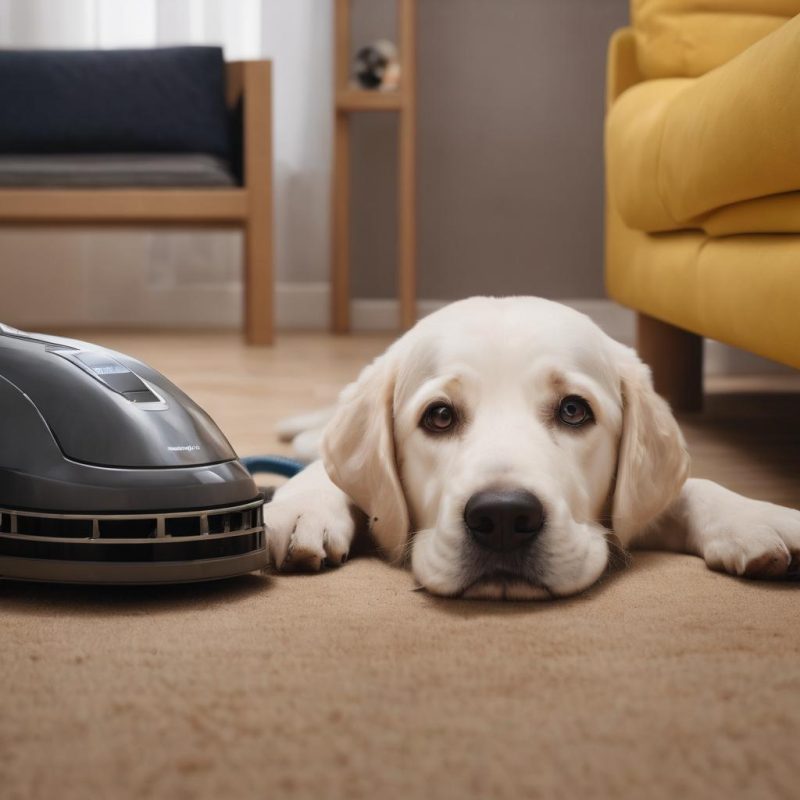Table of contents
- 1. The Noise Factor:
- 2. Vibrations and Movement:
- 3. Appearance and Size:
- 4. Negative Past Experiences:
- 5. Innate Territorial Behavior:
- 6. Sensitivity to Static Electricity:
- 7. Picking Up on Human Vibes:
- 8. Evolutionary Instincts at Play:
- 9. Disruption of Routine:
- 10. The Smell Factor:
- Tips
- Overcoming the Fear:
- Final Words

Ah, the household vacuum – a marvel of modern technology that effortlessly keeps our homes clean. But to many of our canine companions, this seemingly innocent device is akin to a roaring monster. If you’ve ever turned on your vacuum and watched your dog bolt in the opposite direction or display signs of anxiety, you’re not alone. So why exactly are dogs so scared of vacuums? Let’s delve into the psyche of our furry friends and demystify this common phobia.
1. The Noise Factor:
Vacuum cleaners are loud. To the human ear, the noise might be manageable, but consider the superior hearing capabilities of dogs. They can hear at frequencies as high as 65,000 Hz, while humans max out at around 20,000 Hz. This means vacuums produce a cacophony of sounds that are not only louder to dogs but also encompass a broader range of frequencies. The sudden roar of a vacuum can be startling and even painful for them.
2. Vibrations and Movement:
Along with the noise, vacuums produce vibrations that dogs can sense. The movement of a vacuum, especially an upright one being pushed and pulled, can be unpredictable from a dog’s perspective. This unpredictability can induce anxiety as dogs thrive on routine and predictability.
3. Appearance and Size:
To a dog, especially a smaller breed, a vacuum cleaner is a sizable, moving object invading their territory. Its strange shape and the way it moves might make it hard for dogs to understand or categorize, leading to a natural cautious or fearful response.
4. Negative Past Experiences:
If a dog has had an unfortunate encounter with a vacuum in the past, like being accidentally bumped by it or getting its tail or fur sucked in momentarily, it’s bound to associate the vacuum with that negative experience.
5. Innate Territorial Behavior:
Dogs are territorial animals. A vacuum, with its noise and movement, might be perceived as a potential threat or intruder. As a result, dogs might bark, growl, or exhibit protective behavior when they see or hear the vacuum in action.
6. Sensitivity to Static Electricity:
Some believe that the static electricity generated by vacuums can be uncomfortable for dogs, especially those with longer fur. This sensation, although subtle, might be another reason dogs prefer to keep their distance.
7. Picking Up on Human Vibes:
Our pets are incredibly in-tune with our emotions. If you’re anxious about how your dog will react to the vacuum or if you’re frustrated by their fearful response, they can pick up on that energy, which might exacerbate their anxiety.
8. Evolutionary Instincts at Play:
Before being domesticated, dogs were wild animals that relied heavily on their senses to detect potential threats. A vacuum cleaner, in all its noisy glory, could easily be interpreted as a large, unpredictable animal. This ancient instinct to be wary of potential predators could be another layer to their fear.
9. Disruption of Routine:
Dogs are creatures of habit. They love routines and can be unsettled by any significant change in their environment. Introducing a loud, moving object into their usual calm space can be distressing for them. This disruption might be more pronounced if vacuuming isn’t a frequent activity in the household.
10. The Smell Factor:
We often forget that dogs primarily experience the world through their noses. Vacuums suck in all kinds of smells – from food particles to other household scents. This whirlwind of odors being churned out from the vacuum’s exhaust can be overwhelming for a dog’s sensitive nose.
Tips
- Gradual Introduction: Start by letting your dog see the vacuum without turning it on. Allow them to sniff it and get familiar. Over time, turn the vacuum on for short bursts, gradually increasing the duration.
- Positive Association: Pair the presence of the vacuum with something your dog loves. This could be treats, toys, or praise. Over time, they’ll start associating the vacuum with positive things rather than fear.
- Distraction Techniques: Engage your dog in a different activity when vacuuming. This could be a puzzle toy, a stuffed Kong, or a favorite chew toy.
- Use Barriers: Initially, it might help to have a physical barrier between your dog and the vacuum. Baby gates can be handy for this.
- Desensitization Sounds: There are recordings available online of vacuum sounds. Playing these at a low volume and gradually increasing the loudness can help desensitize your dog to the noise.
- Stay Calm: As mentioned earlier, dogs pick up on our energy. If you stay calm and assertive, showing no fear or frustration, it can help your dog understand that there’s no real threat.
Overcoming the Fear:
Understanding the root of the fear is the first step in helping your dog cope. Gradual exposure, positive reinforcement, creating a safe space for your dog during vacuuming sessions, or even investing in quieter vacuum models can all help in alleviating this common canine fear.
Final Words
In conclusion, while a vacuum cleaner might seem like a mundane household tool to us, it encompasses a world of sensory overload for our dogs. With patience, understanding, and love, we can help our furry friends navigate this and other modern-day challenges with ease. After all, their emotional well-being is just as important as a clean floor.
